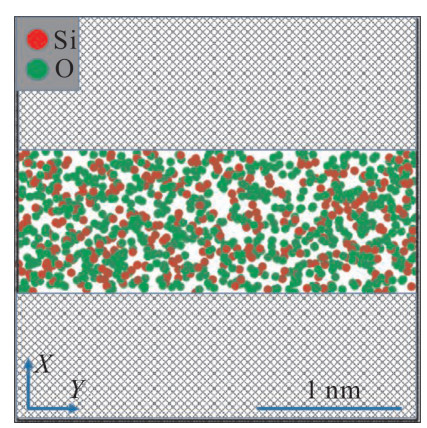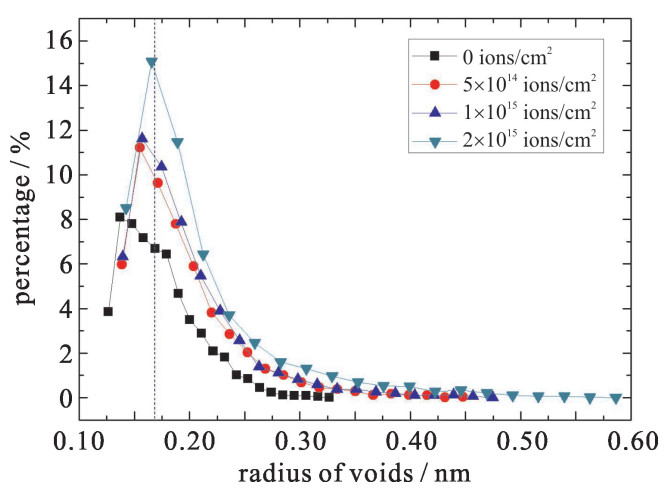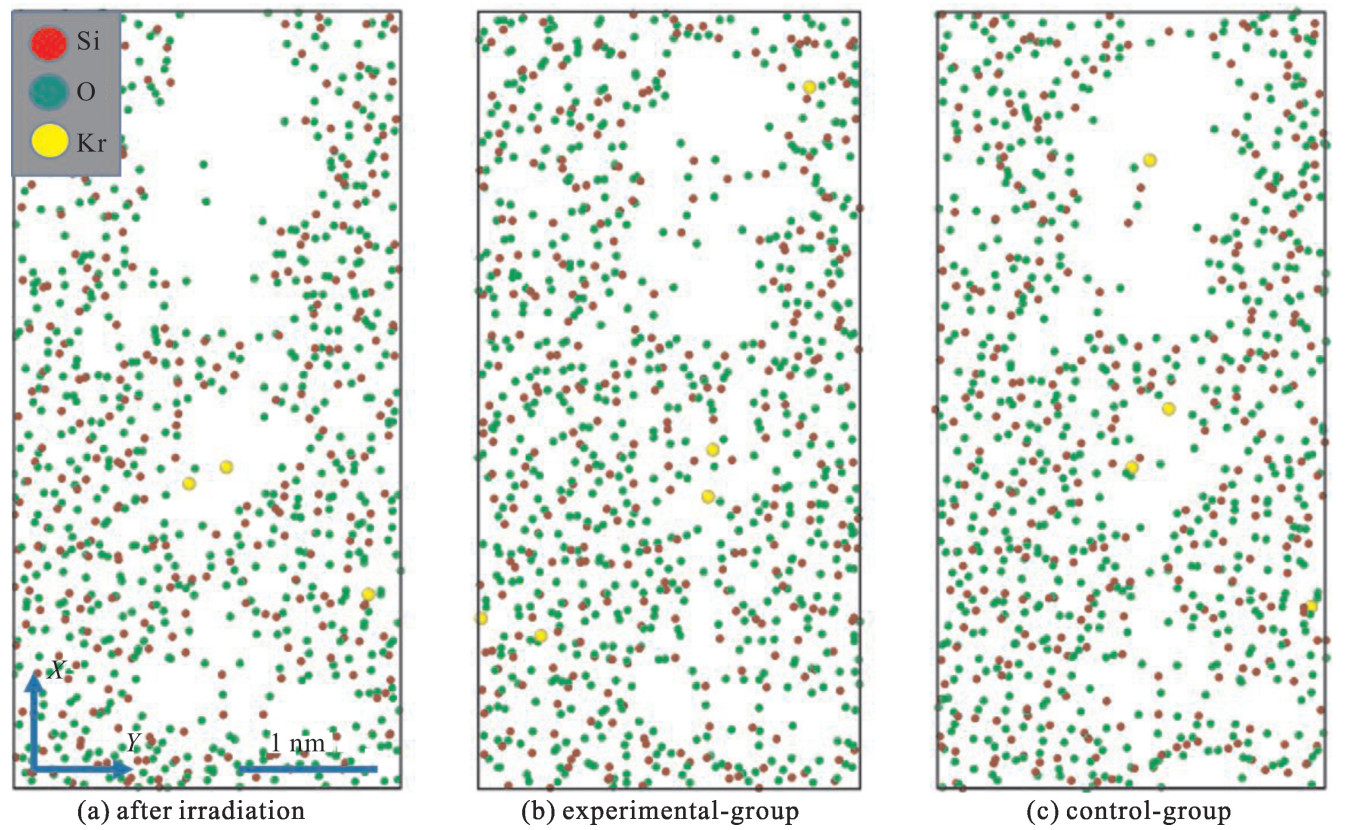Molecular dynamics simulation of mechanism of gas filling and barrier properties of hollow glass microspheres
-
摘要: 为了探讨载能重粒子辐照改善惯性约束聚变中所用玻璃微球的充气性能,以及热弛豫过程中改善其保气性能的微观机制,利用分子动力学的方法对载能重粒子辐照前后的SiO2玻璃在内部形成气体扩散微通道的机理进行了模拟研究。结果表明,重粒子辐照可以在SiO2玻璃中形成明显的扩散通道,说明辐照后的玻璃更适合通入Ar等较大尺寸气体;在高温高压的条件下,形成的扩散通道有逐渐关闭的趋势,辐照产生的缺陷能够在一定程度上得到修复。因此,利用重粒子辐照的方法,可在玻璃体中产生充气的微通道,该通道在高温高压下可实现关闭,从而起到开关的作用。模拟结果可为实验上通过重粒子辐照提升微球玻璃充气保气性能的方法提供理论支持,说明该方法具有可行性。Abstract: In order to investigate the irradiation effects of heavy particles on hollow glass microspheres (HGMs) used in inertial confinement fusion (ICF) and the mechanism during filling gas, the molecular dynamics method was used to simulate the formation of micro-channels before and after irradiation in silica glass. The simulation results show the irradiation of heavy particles have produced obvious channels in silica glasses, which will be better for filling argon gas; the particle channels produced by irradiation have gradually closed under high temperature and high pressure, and the irradiation defects have recovered in some degree. Therefore, the irradiation of heavy particles can produce micro-channels for filling gas, and they can be closed under high temperature and high pressure, which plays the role of a switch. The results provide theoretical support for the experiment of gas filling and barrier properties of microspheres, and also testify the feasibility of the method.
-
表 1 Kieu的势场参数
Table 1. Parameters of Kieu's potential
bond Aij/eV ρij/nm Cij/(eV·nm6) Si-O 45 296.720 0 0.161 0 46.139 5 O-O 9 027.030 0 0.265 0 85.032 1 Si-Si 834.400 0 0.290 0 0.000 0 表 2 恢复过程中的处理流程
Table 2. Processes of recovery
step ensemble time/ps experimental-group 1: heat up npt 4 2: relaxation npt 50 3: relaxation nvt 10 control-group relaxation nvt 64 -
[1] 邱龙会, 魏芸, 唐永建, 等. 液滴法制备空心玻璃微球的过程分析[J]. 原子能科学技术, 2001, 35 (1): 60-64. doi: 10.3969/j.issn.1000-6931.2001.01.011Qiu Longhui, Wei Yun, Tang Yongjian, et al. Analysis on the formation process of hollow glass microspheres fabricated by liquid droplet method. Atomic Energy Science & Technology, 2001, 35 (1): 60-64 doi: 10.3969/j.issn.1000-6931.2001.01.011 [2] Brinker B A, Miller J R. Capillary gas filling of inertial fusion targets[J]. J Vac Sci Technol, 1982, 20 : 1079-1081. [3] 邱龙会, 魏芸. 薄壁玻璃微球壳的热扩散充气[J]. 强激光与粒子束, 1999, 11 (3): 317-320. http://www.hplpb.com.cn/article/id/1180Qiu Longhui, Wei Yun. Gas diffusion fill through hollow glass microspheres with high aspect ratio. High Power Laser and Particle Beams, 1999, 11 (3): 317-320 http://www.hplpb.com.cn/article/id/1180 [4] 宋建明, 何小海, 李波, 等. Ar在玻璃微球中的辐照增强扩散效应研究[J]. 强激光与粒子束, 2006, 18 (3): 415-418. http://www.hplpb.com.cn/article/id/2513Song Jianming, He Xiaohai, Li Bo, et al. Radiation enhancing diffusion of Ar into hollow glass microsphere. High Power Laser and Particle Beams, 2006, 18 (3): 415-418 http://www.hplpb.com.cn/article/id/2513 [5] 张占文, 唐永建, 李波, 等. 空心玻璃微球热扩散法充Ar[J]. 原子能科学技术, 2007, 41 (5): 618-622. doi: 10.3969/j.issn.1000-6931.2007.05.023Zhang Zhanwen, Tang Yongjian, Li Bo, et al. Filling hollow glass microspheres with Ar by method of gas diffusion. Atomic Energy Science and Technology, 2007, 41 (5): 618-622 doi: 10.3969/j.issn.1000-6931.2007.05.023 [6] 南帅, 袁伟, 王铁山, 等. 惯性约束聚变靶丸玻璃微观结构的分子动力学模拟[J]. 强激光与粒子束, 2016, 28: 092001. doi: 10.11884/HPLPB201628.160037Nan Shuai, Yuan Wei, Wang Tieshan, et al. Molecular dynamic simulation of the microstructure of inertial confinement fusion glass target. High Power Laser and Particle Beams, 2016, 28: 092001 doi: 10.11884/HPLPB201628.160037 [7] 陈正隆, 徐为人, 汤立达. 分子模拟的理论与实践[M]. 北京: 化学工业出版社, 2007.Chen Zhenglong, Xu Weiren, Tang Lida. Molecular dynamics simulation theory and practice. Beijing: Chemical Industry Press, 2007 [8] Plimpton S. Fast parallel algorithms for short-range molecular dynamics[J]. Journal of Computational Physics, 1995, 117 (1): 1-19. doi: 10.1006/jcph.1995.1039 [9] Ziegler J F, Ziegler M D, Biersack J P. SRIM—The stopping and range of ions in matter[J]. Nucl Instrum Meth, 2010, 268 (11/12): 1818-1823. [10] Kieu L H, Delaye J M, Cormier L, et al. Development of empirical potentials for sodium borosilicate glass systems[J]. J Non-Cryst Solids, 2011, 357 (18): 3313-3321. doi: 10.1016/j.jnoncrysol.2011.05.024 [11] Ziegler J F. The stopping and range of ions in solids vol 1: The stopping and ranges of ions in matter[J]. Ion Implantation Science & Technology, 1985, 10 (1): 51-108. [12] Stukowski A. Visualization and analysis of atomistic simulation data with OVITO-the open visualization tool[J]. Modelling Simul Mater Sci Eng, 2010, 18: 015012. [13] Roux S L, Jund P. Ring statistics analysis of topological networks: New approach and application to amorphous GeS and SiO systems[J]. Comp Mater Sci, 2010, 49 (1): 70-83. [14] Kerrache A, Delaye J M. Interstitial sites for He incorporation in nuclear glasses and links to the structure: Results from numerical investigation[J]. Nucl Instrum Meth, 2014, 326 (326): 269-272. -






 下载:
下载:




